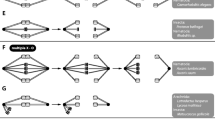Abstract
Lateral asymmetry refers to unequal fluorescent intensity between adjacent regions of sister chromatids. It has been observed in the centromeric regions of mitotic chromosomes of mouse or human origin when cells are grown in 5-bromo-2′-deoxyuridine (BrdU) for a single round of DNA synthesis. The chromosome-orientation fluorescence in situ hybridization (CO-FISH) technique was used with pseudodiploid mouse cells to show that the regions of asymmetrical brightness coincide with major satellite repetitive DNA, and that the more heavily BrdU-substituted chromatid is the one that fluoresces less brightly. These observations support a 20 year old hypothesis on the origin of lateral asymmetry. Other observations suggest that differential loss of DNA from the heavily substituted chromatid also contributes to lateral asymmetry.
Similar content being viewed by others
References
Angell RR, Jacobs PA (1975) Lateral asymmetry in human constitutive heterochromatin. Chromosoma 51:301–310
Flamm WG, McCallum M, Walker PMB (1967) The isolation of complementary strands from a mouse DNA fraction. Proc Natl Acad Sci USA 57:1729–1734
Galloway SM, Evans HJ (1975) Asymmetrical C-bands and satellite DNA in man. Exp Cell Res 94:454–459
Goodwin E, Meyne J (1993) Strand-specific FISH reveals orientation of chromosome 18 alphoid DNA. Cytogenet Cell Genet 63:126–127
Horz W, Altenberger W (1981) Nucleotide sequences of mouse satellite DNA. Nucleic Acids Res 9:683–696
Kim MA (1975) Fluorometrical detection of thymidine base differences in complementary strands of satellite DNA in human metaphase chromosomes. Humangenetik 28:57–63
Latt SA, Wohlleb JC (1975) Optical studies on the interaction of 33258 Hoechst with DNA, chromatin, and metaphase chromosomes. Chromosoma 52:297–316
Latt SA, Davidson RL, Lin MS, Gerald PS (1974) Lateral asymmetry in the fluorescence of human Y chromosomes stained with 33258 Hoechst. Exp Cell Res 87:425–429
Latt SA, Stetten G, Juergens LA, Willard HF, Scher CD (1975) Recent developments in the detection of deoxyribonucleic acid synthesis by 33258 Hoechst fluorescence. J Histochem Cytochem 23:493–505
Lin MS, Latt SA, Davidson RL (1974) Microfluorometric detection of asymmetry in the centromeric region of mouse chromosomes. Exp Cell Res 86:392–395
Lin MS, Davidson RL (1974) Centric fusion, satellite DNA, and DNA polarity in mouse chromosomes. Science 185:1179–1181
Manuelidis L (1975) Consensus sequence of mouse satellite DNA indicates it is derived from tandem 116 basepair repeats. FEBS Lett 129:25–28
Muller W, Gautier F (1975) Interactions of heteroaromatic compounds with nucleic acids. Eur J Biochem 54:385–394
Perry P, Wolff S (1974) New Giemsa method for the differential staining of sister chromatids. Nature 251:156–158
Author information
Authors and Affiliations
Rights and permissions
About this article
Cite this article
Goodwin, E.H., Meyne, J., Bailey, S.M. et al. On the origin of lateral asymmetry. Chromosoma 104, 345–347 (1996). https://doi.org/10.1007/BF00337223
Received:
Revised:
Accepted:
Issue Date:
DOI: https://doi.org/10.1007/BF00337223




